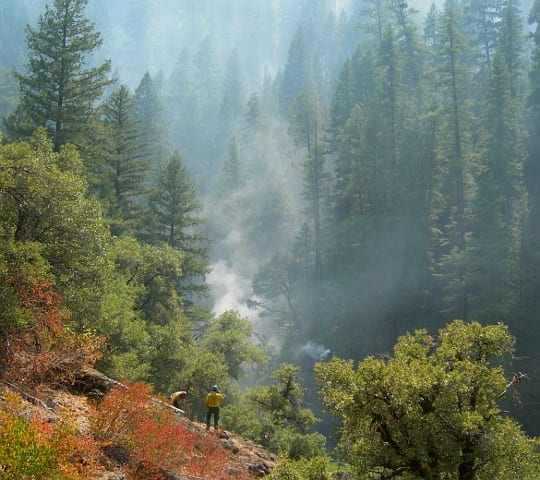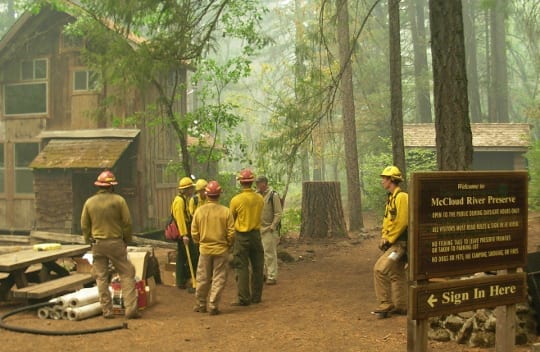Aftermath: The McCloud River Canyon Emerges From The Bagley Wildfire, But What Are The Impacts To The River?
The McCloud River Canyon during the Bagley Fire (photo George Stroud, The Nature Conservancy)
How did one of the world’s most iconic (and breathtaking) trout rivers fare in the face of a massive wildfire?
by Craig Ballenger
In August, wild fires had erupted all over Northern California, but one in particular caught the attention of anglers.
Known as the Bagley Fire, it initially threatened the Pit River Five reach (originally just south of the blaze). But the hot August winds typically blow north from the Central Valley, and this time, they pushed the fire north through the Cascades.
Suddenly, the Pit River wasn’t in danger.
Alarmingly, the McCloud River was.

The McCloud River Canyon during the Bagley Fire (photo George Stroud, The Nature Conservancy)
Ready To Burn
The land was ready to burn. Populated by third-and-fourth-growth conifers combined with massive amounts of understory fuel — and flotsam from previous commercial logging forays — the Bagley fire began burning rapidly towards the McCloud River’s largely pristine canyon.
Widely acknowledged as one of the most fascinating rivers found at this latitude, the McCloud is fed by glaciers and springs originating on 14,179 foot Mount Shasta — the largest stratovolcano in the Cascades.
Once clear of the mountain, the McCloud River serpentines through steep wooded canyons, dropping 2000 feet in under forty miles before emptying into Shasta Reservoir.
Some parts of the canyon are so rugged they’d seen little logging activity, and tje old growth conifer hearken back to the day when the Winnemem Wintu lived here, subsisting on the west’s biggest salmon runs.
For over a century, most of the river and its canyon have been held by private land companies, often for use as exclusive fishing clubs. Though the salmon that jammed the McCloud are long gone, the river boasts a population of native rainbow trout, whose adaptability to both travel and new watersheds found them exported to rivers all over the world.
Ring of Fire
By the time I first saw smoke (I was on the Lake Britton Bridge), the fire had already burned 4400 acres. Before it was finished, the Bagley fire would consume more than 46,000 acres.
Started by a lightning strike and nurtured by a perfect mixture of fuels and low humidity, the Bagley Fire quickly burned north toward the rim of the McCloud River canyon.
Those who watched the progress of the fire feared the vegetation that protected the McCloud from sedimentation in the steep-sided canyon would go up in flames.
There was ample reason for fear.
Local guide Ron Hart, who has spent as much time as anyone on the river during the last 30 years said — based on the ancient fire scars along the canyon old growth — “it doesn’t look to me like it had burned for the past two hundred years at least.””
The good news is that old growth forests often survive “cold” wildfires; the flames burn mostly understory vegetation while the thick bark of old-growth trees protects the trees from the flames.
Still, what would happen once the fire spilled over the ridges and into the canyon was anybody’s guess. Having flown over the McCloud last spring while making a film about the river, I wondered if our footage would be the last this generation would see of an unburned river canyon.
Locals, anglers and river lovers watched anxiously as smoke filled the skies, scanning the web for fire updates each morning. Firefighters on the Bagley blaze described burning debris tumbling off the tops of ridges and down into tributary canyons, and those who had seen it said the potential for a devastating fire was high.
The Forest Service closed the roads to the McCloud (the public normally has access to approximately six miles of the McCloud River, most of it Forest Service land adjacent to two and a half miles of private Nature Conservancy property, which offers access to ten anglers a day), and the rumors flew.
George Stroud, longtime McCloud River Preserve manager for The Nature Conservancy, provided updates throughout the fire, posting photos of the cabins, fire crews gouging away at duff and understory vegetation in ash-filled air, and flames burning at water’s edge.
Eventually, firefighters used the McCloud as a natural firebreak, but acknowledged that the fire could easily jump the river.
If it did, the canyon would likely be lost for a generation.
Fortunately, the winds never really blew, the firelines held, the fire crews worked tirelessly, and the fire was confined to the south side of the McCloud River Canyon.
But what had happened to the river itself?
On The Ground
As soon as the McCloud River was opened to the public, I headed to the Nature Conservancy Preserve alongside expert anglers Mike Weir and Ben Getilicia.
We’d all heard the rumors. The river was either denuded by fire and firefighters, and would surely silt in. Others said the river was wholly untouched by the Bagley fire.
We were anxious to separate speculation from fact. What would the river look like? How were the trout?
On the drive down, Skunk Hill Road and the forest service campground at Ah-Di-Nah were eerily empty.
Once we hit the familiar Preserve trail, what unfolded was a mostly familiar landscape, drawing a collective sigh of relief from the group.
While fiery debris had indeed tumbled down the ridges to the river’s edge, wildfires tend to burn back uphill, so the river canyon was marked by burned areas, but only in a few places. The human defenses were also readily apparent.
In fact, the fire had jumped the river in only one spot (just below the Preserve’s parking lot), but that spot fire had been quickly contained by firefighters.
As we wandered farther down the trail, we found the occasional ‘cigar’ still burning (a cigar is a conifer with its top gone and a bit of smoke and flame puffing from the trunk).
Above Dave’s Pool, just upstream from Bald Mountain Creek, a giant Doug fir had been dropped across the creek, providing access for the fire line which had been gouged out of the forest floor.
At the cluster of Nature Conservancy cabins, we saw that fire crews had cleared away the understory conifer, young riparian saplings and willows, and we were told they’d brought in rolls of fire-resistant material to wrap the cabins should the fire jump the river.

Firefighters gather at the Nature Conservancy’s Cabins on the McCloud. Note the mylar rolls waiting to be applied to structures. (Picture George Stroud, The Nature Conservancy)
Chris Babcock, Nature Conservancy scientist and caretaker, was enthusiastic and grateful for the care crews had shown in the area: “Those guys were ready to wrap the cabins in sheets of mylar — they worked their asses off. They totally respected the river and property. They were amazing.”
Babcock continued, “I offered a couple of those guys a fly rod I had sitting around after they asked me how the fishing was on the river. Their crew chief jumped right in and made it clear they had no time to toss a fly at trout.”
“He later told me his crew got it — where they were and what an amazing spot they were charged with protecting. They were totally dialed in.”
Ultimately, the fire burned 345 of the Conservancy’s 2330 acres.
George Stroud’s view is that the McCloud River “was fortunate for many reasons. The most significant is that the fire worked downhill and therefore remained a low intensity, understory burn.”
“Also, the river canyon itself burned towards the end of the Bagley Fire timeline, so significant resources — including hundreds of firefighters — were devoted to defending the river canyon.”
Will The McCloud Suffer?
While the McCloud seems to have survived the fire with little damage, the upcoming winter and spring seasons will see the biggest impacts.
According to Stroud, the worst-case scenario involves a large rainstorm, which would wash newly available sediment right into the river, both clouding it and strangling some of the McCloud’s excellent habitat.
The best case scenario involves a series of small storms; just wet enough to wet the burned soil and grow vegetation.
Fortunately, the Forest Service is already attempting to mitigate the impacts of their firelines, and because water quality studies have been conducted at the Preserve for years, it’s possible to measure the impacts on the river (a testament to the value of long-term monitoring programs on our trout waters).
Effects of the fire on angling and the fishery are encouraging.
October Caddis — one of the river’s superhatches — now grace the autumn canyon. Pacific dogwood and diminutive mountain maple are melting to crimson. Alder and big leaf maple along the water’s edge are drifting from green to gold.
The Elephant Ears are turning too. Trout still rise to the McCloud’s mid-afternoon blue wing olive mayfly hatch, and the river’s wild rainbow and brown trout remain fat and sassy following a season’s feeding.
We drifted nymphs, stripped streamers, tossed small mayfly imitations and floated big caddis patterns through the lanes which we knew housed 18-20 inch rainbows. The big browns, growing here to the size of big Trinity steelhead, are moving with less caution to flies as their spawning season becomes imminent.
As we trudged back up the trail in the evening light, the scent of lingering woodsmoke wafted through the air. Against the deep green backdrop of canyon conifer across the river, a smudge of gray occasionally highlighted remnant embers.
The trail is unusually dusty — a silent reminder of the fire crews who marched through here in their heavy boots. They were part of a flood of people clambering along the canyon in greater numbers than the river’s seen since its native villagers plied the river for salmon more than 150 years ago.
As someone might put it, the McCloud abides.





9 Comments
Great News! Great article. I concur with everything you said, I fished it the second day it was open and did not see a soul or a big brown trout. I was there swinging for just that reason, but did get some beautiful bows. I was pleasantly suprised to see it was mostly undergrowth that had burned. Lets pray for some gentle storms to get some vege’s growning to help stabilize the slopes. To all the firefighters who busted their asses as they do with every fire. JOB WELL DONE!!!
And Thanks!
Will
We agree. The Nature Conservancy people couldn’t say enough good things about the fire crews, who were very careful not to unduly damage anything, but still protected everything.
To the firefighting crews who helped to save the McCloud River: THANK YOU from the bottom of my heart. Your bravery and courage under such brutal conditions and fighting to save such an amazing river will never be forgotten. THANK YOU again.
Yes. They did a remarkable job, though everyone admits that a day of strong winds would have made the job impossible. We were all lucky it stayed calm.
I have experienced many times how fires bring a community together to work insanely hard to protect Mother Nature and the people who live there. This is a great example.
A group of us spent the last week of September at the Bollibokka Club and saw no ill affects from the fire.
Let’s hope the winter is a good one, and that no part of the river suffers if the weather goes wrong.
God bless every firemen every where.